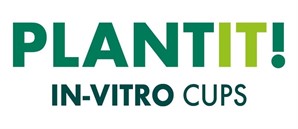In-Vitro PLANTS
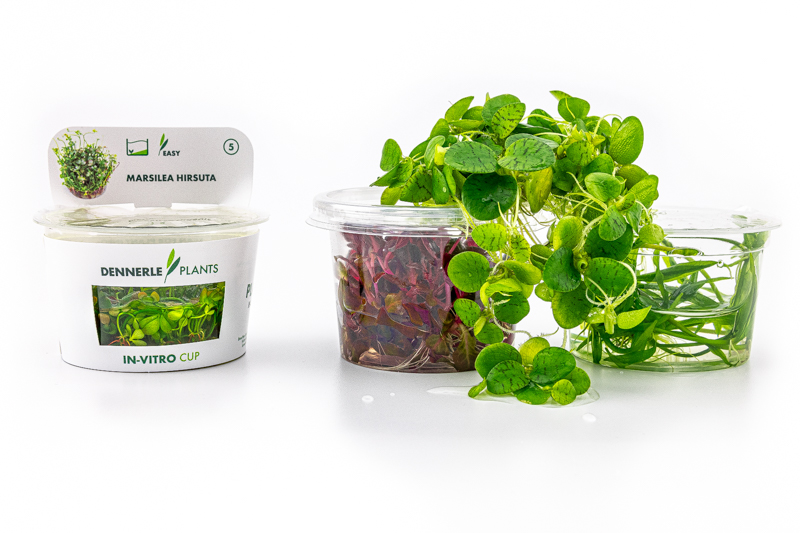 The propagation of plants are an interesting and exciting subject for any gardener in commercial horticulture, as well as for any amateur gardener in their garden or living room.
The propagation of plants are an interesting and exciting subject for any gardener in commercial horticulture, as well as for any amateur gardener in their garden or living room.
A distinction is made between generative (sexual) reproduction by means of seeds, and vegetative (asexual) reproduction by separating parts of plants. These then develop to form completely new plants. The latest method of vegetative reproduction is tissue culture in a plant laboratory.

In-Vitro culture (latin: in glass), as it is also known, has existed for many decades and developed from the need to propagate robust, healthy plants when creating new varieties in ornamental plant production. In this process, tiny parts of plants are removed under sterile conditions and cultivated on a suitable nutrient medium.
Meristems - copied blueprints
The most common method of this asexual laboratory reproduction is carried out using meristem tissue. All plants have meristem or cambium tissue at the shoot tips. This type of tissue is made up of undifferentiated cells that contain the entire "blueprint" of a plant species. These parts of the plant can only be removed in the laboratory under sterile conditions, as this young tissue would be an ideal nutrient substrate for all possible fungal diseases, whose pathogens are always present. The harvested clumps of cells are put into special containers on an artificial nutrient substrate and after approx. 6-8 weeks young plants form from them.
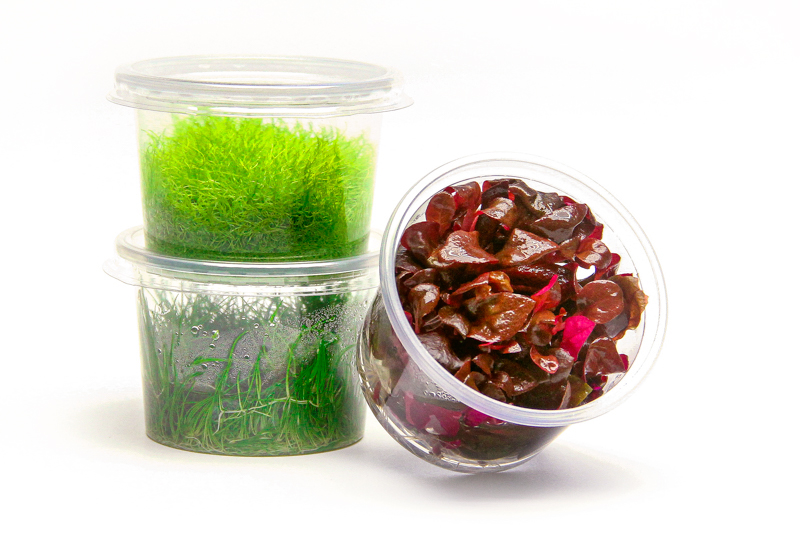
A contribution to conservation
This kind of vegetative reproduction has also been used in the production of aquarium plants for over 20 years. A familiar example is the modern production of Cryptocorynes. Cryptocoryne species grow relatively slowly and can only be propagated by means of division. However, this is not very productive and is rather difficult to do commercially.
Consequently, this species was generally "harvested" from wild stocks and sent to Europe. Many easy-to-grow species come from Sri Lanka. Due to ever increasing demand in the 70s and 80s, they have been dramatically decimated in their natural habitat over the century.
Only meristem propagation in the laboratory has made it possible,
to stop this uncontrolled removal from the wild.
Another advantage was the reliable propagation of certain sub-species with their typical features. It is also worth noting that some species are very variable such as Cryptocoryne wendtii. In its natural habitat, this plant, which is very popular in aquatics, appears in very variable growth forms. These can include differences in color or in habit.
In meristem propagation however, these features can always be reproduced in an identical form. It is also theoretically possible to use continuous division to produce an unlimited number of new plants from a single cell, which all have the same features of the parent plant, and are as alike as peas in a pod.
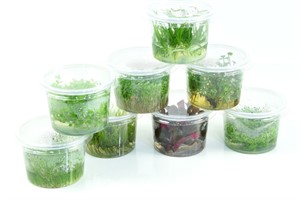
Many familiar aquarium plants are now produced in this way. Some include Anubias, Cryptocorynes, Ceratopteris, Hemianthus, Hydrocotyle and Pogostemon. In principle, anything goes, but for some plants, a different method of vegetative propagation is more interesting and economical.
Echinodorus is a good example. This genus forms what are known as plantlets with roots, on the flower stalk. These can be removed when they reach a certain level of maturity and re-potted.
It is also different for the true aquatic plants that can only be cultivated under water (such as Vallisnerias or Cabomba). For these, meristem cultivation is not an option.
The aquarium plants preferred for this type of propagation are all marsh plants . This means they are able to grow both above and below water. When cultivated in special culture vessels, the plants form the typical submerged (underwater) growth features. However, in the greenhouse, the young plants must initially acclimatize to life above water again. This actually happens very quickly. After just two to three weeks, the "babies" from the laboratory acclimatize to the new environment and grow emersed (above water) leaves again.
Clones for everyone
A logical further development is the marketing of little mini tubs for aquatics fans. This originated at Dennerle from the problem of cultivating a plant and marketing it.
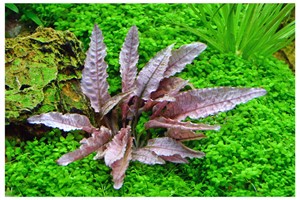
Cryptocoryne sp. 'Flamingo' was found in a clump of Cryptocoryne wendtii 'Brown'. This striking pink plant was propagated in the laboratory and like all other Cryptocorynes, was to be grown on in pots for several months until it reached sale size. Unfortunately, all attempts at above water cultivation failed, while the plants in the aquarium continued to grow steadily. As a result, we decided to market this rarity in mini tubs directly from the laboratory.
From these beginnings, Dennerle developed a new range of plants: plantit! - In-Vitro plants in mini cups. The range includes a variety of plant types such as the groundcover plant Hemianthus callitrichoides 'Cuba' and the new Micranthemum tweediei 'Montecarlo', foreground and midground plants such as Rotala indica (syn. Ammannia spec.Bonsai) and Staurogyne repens, but also some rarities such as Eichhornia diversifolia and the scarce Cryptocorynes usteriana and Cryptocoryne x purpurea.
 All of these plants have one thing in common: they are all cultivated under sterile conditions. This means no pest infestations or pathogens arise there is no algae growth, they contain no snails or snail eggs, the plants are very compact and highly branched, and their submerged habit eliminates the changeover phase from emersed to submerged in the aquarium.
All of these plants have one thing in common: they are all cultivated under sterile conditions. This means no pest infestations or pathogens arise there is no algae growth, they contain no snails or snail eggs, the plants are very compact and highly branched, and their submerged habit eliminates the changeover phase from emersed to submerged in the aquarium.
The plantit cups are especially well-suited to aquascaping. Their small size means you can in- sert the plants into the hardscape between stones and roots very easily.
However, you have to be quite patient, as the plants are significantly smaller than aquarium plants that are cultivated conventionally in pots.
Plantit plants are also a good way for shrimp enthusiasts to add new plants to already well-established aquaria containing shrimps. It is not necessary to water the plants for several days as per usual. The gelatinous nutrient medium should simply be carefully washed off.
As a general rule, the plant cushion should then be divided into small pieces and planted at intervals in the substrate. Just as the slogan says: Clean it! Cut it! Plant-it!
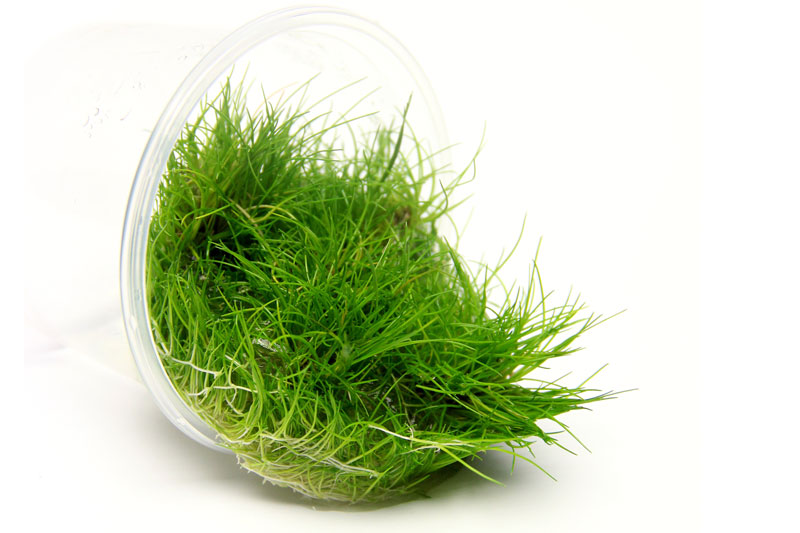
_____________
Love In-Vitro Plants?
Check out the full range of Dennerle PLANTIT! In-Vitro Cups.
